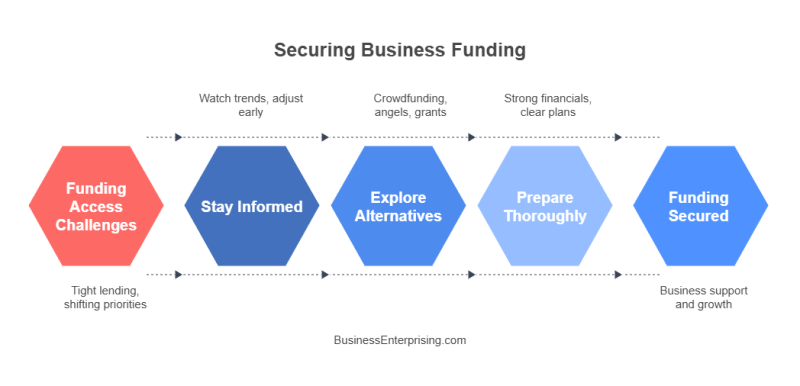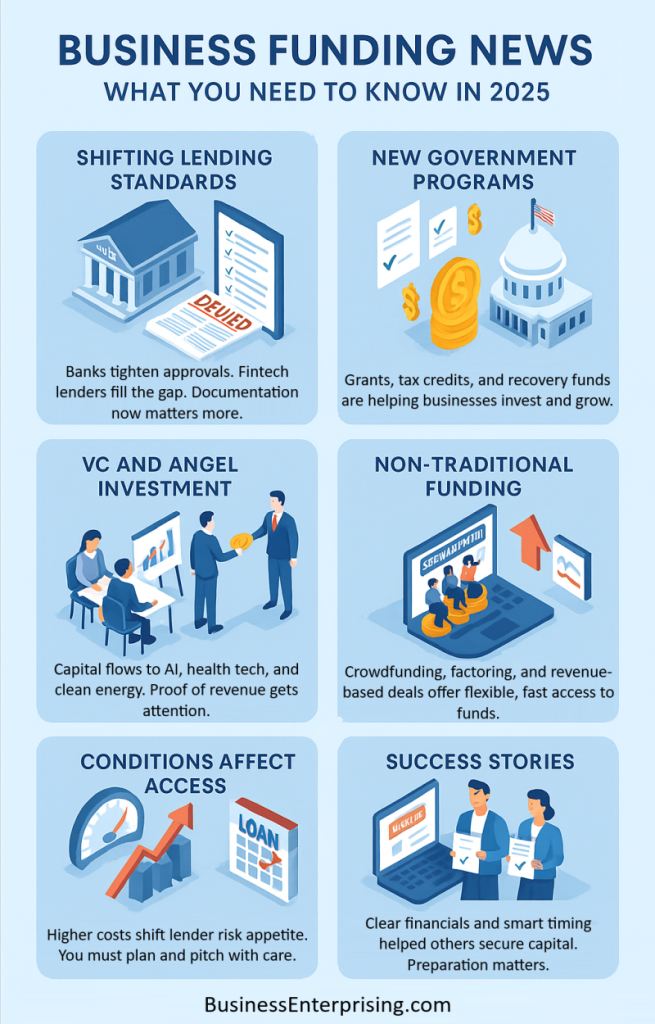
Additionally, lenders now place greater weight on cash flow and repayment capacity. That means you need strong numbers and clear plans. Venture capital firms are also shifting focus. They favor businesses with proven traction and clear revenue models. If you’re just starting, this can make equity funding harder to secure.
However, some startups are still getting funded. Crowdfunding, angel investors, and grant programs have helped fill the gaps. Therefore, you might find success by exploring these lesser-known paths. Each comes with its own pros, cons, and process. You must decide what fits your business stage and goals.
Inflation and global events continue to affect financial markets. As a result, lenders are more cautious. Therefore, your approach needs to be both realistic and well-prepared. Strong records, thoughtful budgeting, and a focused pitch can make a big difference.
If you want to compete for funding, timing and strategy matter. You can’t control the market, but you can control how ready you are. By watching trends and adjusting early, you stay ahead. That gives you more options and a better shot at success.
Recent Trends in Small Business Lending
Lending conditions for small businesses have shifted in the past year. Banks are more cautious and now require stronger financials. At the same time, approval rates have dropped, especially for first-time borrowers or early-stage startups. Traditional lenders want lower risk and tighter documentation before funding anything new.
However, fintech lenders have stepped in to fill some of the gaps. These platforms move faster and often require less paperwork. Many small business owners now turn to them when banks hesitate. Therefore, fintech lending has grown, particularly for short-term and working capital loans. This trend shows no sign of slowing down anytime soon.
Interest rates have also changed the funding equation. Because of recent rate hikes, borrowing costs have gone up across the board. As a result, businesses are more selective about which loans they accept. You may notice that many are delaying major investments or reducing loan amounts. Lower interest rate programs from the SBA have gained more attention as a result.
Additionally, some SBA lenders have expanded their outreach to underserved markets. They are testing more flexible underwriting guidelines and digital tools. While this helps, funding still remains harder to access than before. That said, the need for capital has not gone away. Therefore, staying updated on business funding news matters now more than ever.
If you’re planning to seek financing, watch how these trends affect your chances. You may need to adjust your strategy or explore new lending channels. Staying proactive and informed will improve your odds. Always compare options and understand the real cost of borrowing before you decide.
New Government Funding Initiatives
Government programs have continued to roll out new funding options for small and mid-sized businesses. These include grants, tax credits, and subsidies. Many of these programs target specific industries, minority-owned businesses, or companies in distressed areas. You may find opportunities at the federal, state, or even local level.
Additionally, several states have increased funding for small business innovation and sustainability projects. Some offer matching grants that help cover marketing, equipment, or workforce development costs. Others provide direct cash awards for businesses creating jobs in underserved regions. Therefore, it is worth reviewing your state’s economic development office regularly.
The federal government has also introduced new tax credits. These support businesses investing in energy efficiency, training, or R\&D. If your company qualifies, you could reduce your tax bill significantly. However, the application process may take time. You should prepare documents early and keep accurate records of expenses.
Local governments have added their own programs as well. Some counties offer stimulus-style grants to help businesses recover from economic disruptions. These funds are often limited, so timing matters. Therefore, you must apply quickly and meet all requirements.
Staying current with business funding news helps you spot these opportunities before they close. You might miss out if you wait too long or skip the fine print. Additionally, some programs require follow-up reporting or ongoing compliance. Make sure you understand what comes with the funding you accept. If you’re looking to reduce risk or fund growth, public resources can help. Review options across levels of government and act fast. Taking advantage of what’s available now could support your goals without adding debt.
Venture Capital and Angel Investment Activity
Venture capital activity has started to rebound after a slower period last year. Investors are now showing more interest in scalable tech. However, they remain selective and want clear paths to revenue and growth. Therefore, early traction and strong teams matter more than ever.
Additionally, artificial intelligence continues to attract funding. Startups offering AI tools for business, healthcare, and logistics have raised large rounds. Fintech is also showing signs of life again, although at more conservative valuations. You may notice that deals are smaller but more frequent compared to past years.
Health tech and clean energy are gaining momentum as well. These industries offer long-term growth and attract mission-driven investors. Therefore, if you’re building in those spaces, funding may be easier to access. However, you still need to prove your market fit and long-term potential.
Angel investors have also returned with renewed interest. Many focus on local or niche markets. You may have more success reaching them through networks or demo events. Additionally, some angels now pool resources through syndicates to reduce personal risk. That structure makes it easier for newer investors to participate in early-stage deals.
Recent business funding news highlights several notable funding rounds. AI software, green manufacturing, and telehealth companies have all closed multimillion-dollar deals. These signals show cautious optimism in the private investment space.
If you plan to raise capital, watch where investors are focusing. Pitch clearly, keep your numbers tight, and build early proof. That approach gives you a better shot at attracting the right partners at the right time.
Alternative Financing Options Gaining Traction
Alternative financing options are gaining attention as traditional lending tightens. Many business owners are looking beyond banks for working capital. Crowdfunding has grown rapidly, especially for consumer products and mission-driven ventures. You can raise funds without giving up control or taking on debt.
Additionally, revenue-based financing has become more common. This model lets you repay a percentage of monthly revenue instead of fixed payments. Therefore, cash flow remains steady, especially during slower periods. Many e-commerce brands and subscription businesses now use this option to fund growth.
Invoice factoring is also making headlines. You sell unpaid invoices to a third party in exchange for quick cash. This helps maintain operations without waiting for customers to pay. However, factoring costs vary, so you should compare terms carefully.
Other creative tools are emerging too. Some platforms offer small business cash advances tied to daily card sales. Others connect peer lenders to local entrepreneurs. These sources may carry higher fees, but approval can be faster and more flexible. Therefore, they appeal to those with less traditional credit profiles.
Recent business funding news reflects the shift toward these alternatives. Business owners want speed, flexibility, and less red tape. As a result, non-traditional finance is no longer seen as a last resort. It has become a practical option for those needing fast access to capital.
If you’re struggling with slow approvals or tough credit rules, consider these tools. However, always check the long-term cost. Choosing the right structure can keep your business moving without adding unnecessary pressure.
Impact of Economic Conditions on Funding Access
Economic conditions have made funding access more difficult for many business owners. Higher inflation has raised operating costs and reduced spending power. As a result, lenders have become more cautious when reviewing loan applications. They want stronger financials and clearer repayment plans before saying yes.
Additionally, interest rate hikes have pushed borrowing costs higher. This affects both loan demand and lender risk tolerance. You may find fewer options or more expensive terms when you shop for financing. Therefore, many entrepreneurs are delaying funding or choosing smaller amounts.
Global instability adds another layer of uncertainty. Supply chain issues, currency shifts, and geopolitical tension all impact business projections. Because of this, lenders tighten their criteria and pull back from riskier sectors. However, some industries like clean energy or logistics may still attract attention.
Recent business funding news shows a rise in creative strategies. Entrepreneurs are seeking out grants, pitch contests, and alternative financing to avoid traditional debt. Additionally, some are cutting costs or raising prices to stay self-funded longer. You might consider similar steps if your credit or cash flow has been affected.
If you plan to raise capital, prepare for more scrutiny. Lenders will want to see your cash reserves, projections, and backup plans. Therefore, get organized and focus on financial clarity. A solid plan helps you stand out, even in a slower credit market.
By watching economic signals and adjusting your timing, you can improve your odds. Funding is still available, but the path may look different than before.
Funding Success Stories and Case Studies
Some of the best business funding news comes from real companies that found success. One small food brand raised seed funding after hitting consistent monthly sales. The founder focused on direct-to-consumer marketing and kept costs lean. Therefore, when they pitched to investors, their numbers told a clear story.
Another example comes from a regional logistics startup. They secured a line of credit after showing strong demand and clear customer contracts. Additionally, they had no debt and a positive cash flow. That helped ease lender concerns during a time of rising rates.
A third case involves a local tech company. It used crowdfunding to raise \$250,000 from loyal customers and early fans. This not only funded development, but also built a stronger community. Therefore, the campaign helped with both capital and customer loyalty.
Many founders overlook the importance of timing and preparation. However, these stories prove that both matter. You should clean up your financials and practice your pitch early. Additionally, you must understand your numbers and be ready to answer hard questions.
These businesses didn’t wait for perfect conditions. They acted based on real demand and used the right funding method for their stage. If you need capital, look at what others are doing. Learn from their mistakes and copy their smart moves.
Business funding news often highlights big rounds, but small wins matter too. If you build value and keep moving, your chances improve. You don’t need to be flashy to get funded. You need to be prepared, focused, and clear about where you’re going.
Conclusion
Access to capital keeps changing, and staying flexible helps you keep up. Lending terms shift, and new programs launch without much notice. Therefore, you need to follow the trends and adjust your approach as needed. Pay attention to what’s working and where funding is flowing.
Additionally, each business stage brings different needs. Early ventures may benefit more from grants or crowdfunding. More established companies might lean toward credit lines or equity deals. However, timing and preparation often make the biggest difference. You must have clean financials and a clear use for the funds.
Business funding news continues to highlight creative deals and new sources. That means opportunities still exist if you act with purpose. Therefore, keep your pitch simple, back it with real data, and be ready to answer tough questions. Investors and lenders both want confidence and clarity.
If one source turns you down, try another. You may find better terms through a different channel or at a later stage. Additionally, talk with others who have raised capital. Their advice could save you time and improve your strategy. Learning from others often leads to better results.
Most importantly, keep moving forward. Delays will happen, but persistence matters more. You don’t need to chase every trend. Focus on your business, stay informed, and act when the time is right. When you combine planning with patience, the right funding path will become clear.



